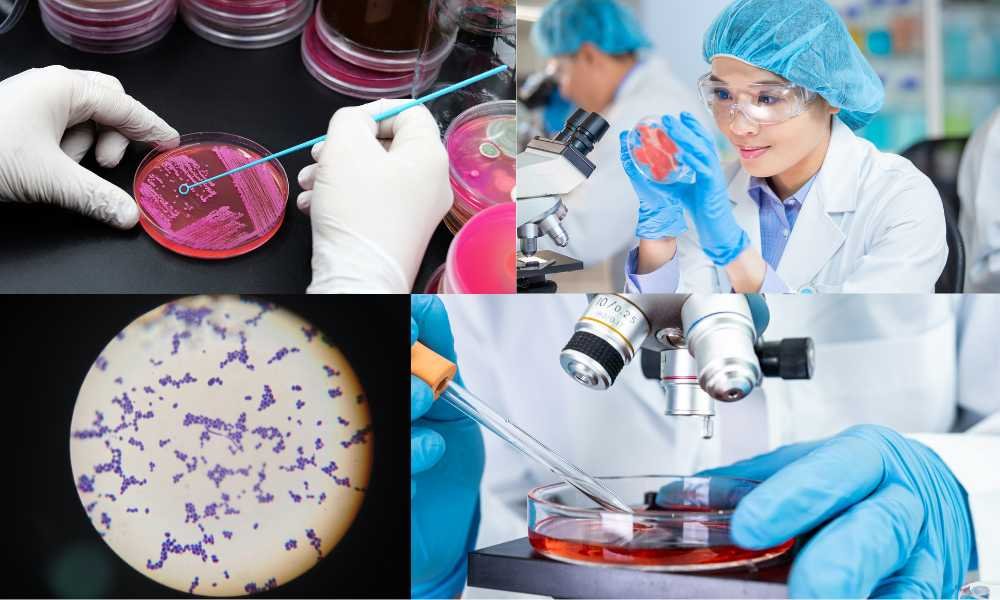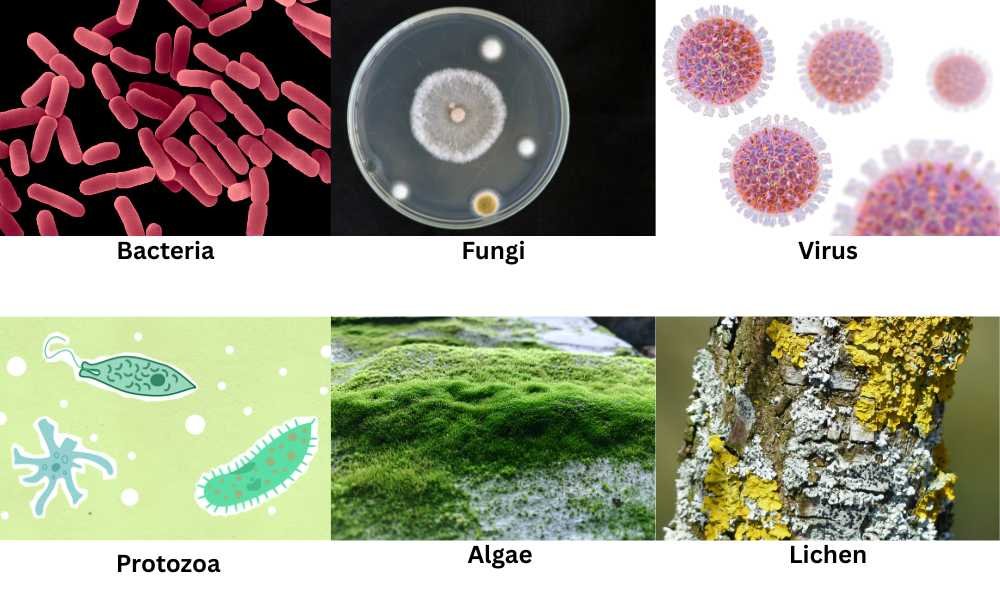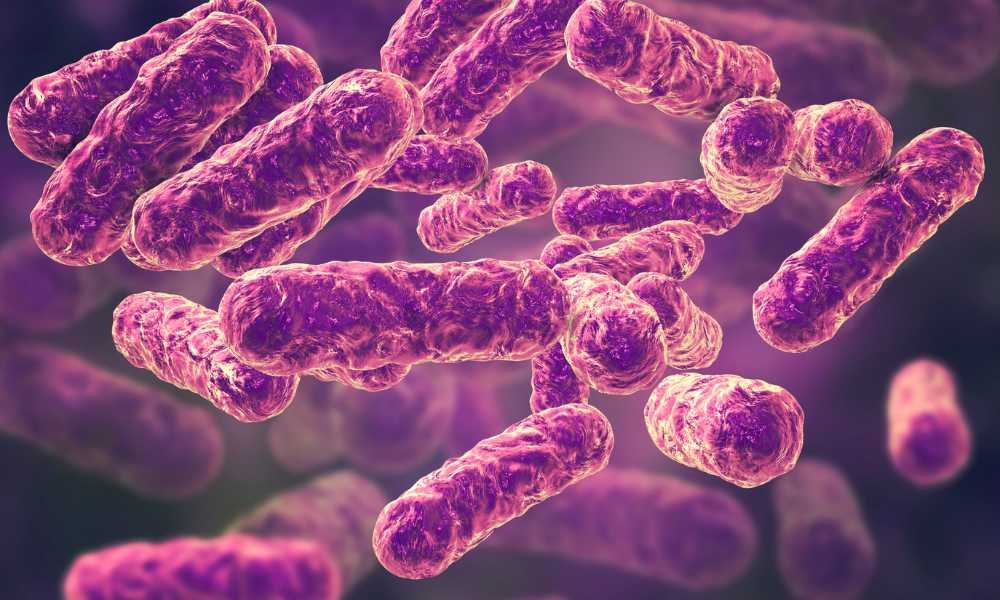Table of Contents
ToggleIntroduction
Microbiology is the scientific study of microorganisms—tiny, often microscopic organisms also known as microbes. These include a diverse group of life forms such as bacteria, archaea, algae, fungi, protozoa, and viruses. Microbiology plays a crucial role in understanding the structure, classification, function, and behavior of these organisms, as well as how they can be both harnessed for beneficial purposes and controlled to prevent harm.
The origins of microbiology date back to the 17th century, when scientists first discovered that life forms invisible to the naked eye existed. This breakthrough revolutionized science and medicine. However, the idea that invisible entities could cause disease and decay had already been proposed as early as the 13th century.
The term “microbe” was officially coined in the late 19th century to collectively describe these microscopic entities. Initially thought to be related, microorganisms were later found to be a vastly diverse group. Over time, microbiology developed into a specialized scientific field that revealed the incredible complexity and variety of microbial life.
Today, microbiology is essential across numerous fields, including healthcare, agriculture, environmental science, biotechnology, and food safety. From studying infectious diseases to discovering new antibiotics and understanding the human microbiome, microbiologists continue to uncover the hidden world of microbes and their profound impact on life.

Principle
Microbiology is the scientific study of microorganisms—minute, often microscopic life forms such as bacteria, fungi, viruses, protozoa, and algae. This field focuses on understanding the diversity, structure, metabolism, genetics, ecology, and pathogenicity of these microbes. Despite their small size, microorganisms play vital roles in biological processes like nutrient cycling (e.g., nitrogen fixation, decomposition), fermentation, and disease causation.
Microbiology explores how microbes grow, metabolize nutrients, reproduce, and interact with their environment and host organisms. These interactions can be beneficial, such as in the case of probiotics, biofertilizers, and biotechnology, or harmful, leading to infections, food spoilage, or contamination.
To study and identify microorganisms, microbiologists use specialized techniques including microbial culturing, microscopy, staining methods (e.g., Gram staining), biochemical testing, and molecular biology tools such as PCR and DNA sequencing. Essential practices in microbiology also include sterilization, aseptic techniques, and microbial control methods to ensure laboratory safety and effective handling of microbes.
Microorganisms To Be Introduced

1. Bacteria
The prokaryotic bacteria are tiny, single-celled organisms that lack a real nucleus. They may be found anywhere, including in the air, soil, water, and even within us.
History
Using his rudimentary microscope, Antonie van Leeuwenhoek was the first to observe it in the 1670s. Christian Ehrenberg gave them the name bacteria in 1828. Significant finding: Louis Pasteur and Robert Koch established that germs can cause diseases (Germ Theory).
2. Fungi
Mushrooms, yeasts, and molds are all examples of fungi. They aid in decomposition and nutrient recycling and are eukaryotic and no photosynthetic.
History
In the early 1800s, Elias Magnus Fries was the first to classify it as distinct from plants. Following Pasteur’s 19th-century research on yeast fermentation, I studied microbiology. Significant role in both food (bread, beer) and medicine (antibiotics like penicillin).
3. Protozoa
Water and soil are common habitats for protozoa, which are single-celled eukaryotes. Many are able to move around using cilia, flagella, or pseudopodia.
History
Antonie van Leeuwenhoek was the first person to see them, in the 1670s, and he referred to them as animalcules. Originally included with animals, it was subsequently placed in the Kingdom Protista, which was established in the 19th century. Famous for the diseases it causes, such as malaria (Plasmodium).
4. Algae
The majority of algae are photosynthetic aquatic creatures. They can be tiny (phytoplankton) or big (seaweeds).
History
Seen by early microscopists, such as Leeuwenhoek, in the 1600s. Linnaeus used the term algae in the 19th century to refer to basic plants. Crucial to the production of oxygen and as the foundation of aquatic food chains.
5. Virus
A virus is a non-living infectious particle composed of DNA or RNA that is protected by a protein coat. They are only capable of replicating within host cells.
History
The idea of viruses first emerged in 1892 during Dmitri Ivanovsky’s investigation of Tobacco Mosaic Disease. The term virus, which means poison, was invented by Martinus Beijerinck. The virus’s structure was initially discovered using an electron microscope in the 1930s. Well known today for contributing to diseases such the flu, COVID-19, and HIV.
6. Prions
Infectious proteins that do not have DNA or RNA are called prions. They result in neurodegenerative disorders by causing the brain’s regular proteins to fold improperly.
History
The term “prion” (proteinaceous infectious particle) was coined by Stanley Prusiner, who made the discovery in 1982. Well-known for inducing ailments such CreutzfeldtJakob disease in people and Mad Cow Disease (BSE). Because they spread without any genetic material, they are unique.
7. Lichen
A lichen is a symbiotic relationship between a fungus and an alga or cyanobacterium. They thrive in challenging conditions and may be found on trees, rocks, or walls.
History
In 300 BC, the Greek philosopher Theophrastus was the first to characterize it as a plant. The Dual Theory, which defines lichen as a relationship between fungus and algae, was put forth by Schwendener in 1867. Currently important as bioindicators for air pollution.
8. Molds
Multicellular fungi known as molds develop as filaments (hyphae). They are frequently found on decaying food, wet walls, and soil, where they seem hazy.
History
Known to people for ages (moldy bread, food rotting). The discovery of penicillin by Alexander Fleming from the mold Penicillium in 1928 marked a scientific breakthrough in the field of antibiotics. Widely used in medicine and biotechnology nowadays.
Branches of microbiology
Pure Microbiology
Pure microbiology is a branch of microbiology that concentrates on the fundamental study and categorization of microbes according to their taxonomy, which is their biological grouping. It focuses on comprehending the morphology, physiology, genetics, ecology, reproduction, and evolutionary connections between various microbial groups, rather than on immediate practical uses.
This area is solely focused on scientific and research, with the goal of understanding and characterizing the fundamental traits and diversity of microbes such as bacteria, viruses, fungi, algae, protozoa, and parasites. The primary objective is to raise understanding of microbial life forms and their interactions with the environment, humans, animals, and plants.

1. Bacteriology
The field of microbiology known as bacteriology is concerned with the study of bacteria, which are prokaryotic, single-celled organisms. It encompasses the categorization, morphology, physiology, genetics, and biochemistry of bacteria, as well as their function in industry, agriculture, health, and illness. Both beneficial bacteria (used in bioremediation, biotechnology, and fermentation) and pathogenic bacteria that cause illnesses in people, animals, and plants are the focus of bacteriologists.
2. Virology
The discipline of virology studies viruses, which are obligate intracellular parasites that lack cells and need a host cell in order to reproduce. This involves researching viral structure, categorization, genetics, replication processes, host-virus interactions, and transmission methods. Virology is essential to biotechnology, gene therapy, vaccine development, and antiviral medication development.
3. Mycology
The study of fungi, including yeasts, molds, and mushrooms, is called mycology. The topics covered include fungal taxonomy, morphology, physiology, reproduction, genetics, and ecological functions. Mycologists examine both useful fungi (utilized in antibiotics, food production such as bread and beer, and biodegradation) and harmful fungi that cause plant diseases (e. g. , rusts and smuts) and human infections (Ex: candidiasis, aspergillosis).
4. Phycology
Phycology, also known as algology, is the branch of microbiology that studies algae, which are photosynthetic, eukaryotic microorganisms that may be found in terrestrial, freshwater, and marine settings. It covers studies on algal classification, physiology, biochemistry, environmental functions, and potential business uses. Algae are researched by phycologists for their significance in generating oxygen, fixing carbon, and as a source of food, biofertilizers, and biofuels.
5. Protozoology
Protozoa are unicellular eukaryotic microbes that belong to the kingdom Protista, and they are the subject of protozoology. These species are researched because of their varied feeding, movement, reproduction, and life cycles. Protozoologists study parasitic protozoa that cause human illnesses such malaria (Plasmodium spp.), amoebiasis (Entamoeba histolytica), and sleeping sickness (Trypanosoma spp.) as well as free-living protozoa that may be found in aquatic habitats.
6. Parasitology
Parasitology investigates parasites, their biology, life cycle, interactions between hosts and parasites, and the illnesses they induce. It encompasses a wide variety of species that live on or within their hosts, frequently causing harm, such as protozoa, helminths (parasitic worms), and arthropods (like ticks and lice).
7. Nematology
Nematology studies nematodes, popularly known as roundworms, which are unsegmented, long worms that live in soil, freshwater, and marine ecosystems. Nematologists look at their taxonomy, physiology, behavior, and ecological functions. Some nematodes are useful, performing vital functions in the cycling of soil nutrients, while others are severe agricultural pests that cause root damage to crops (Ex: root knot nematodes, Meloidogyne spp.).
Applied Microbiology
1. Industrial Microbiology
It covers the application of many microorganisms in manufacturing processes. Waste water treatment and industrial fermentation were the primary applications. Due to the connection between biotechnology and the modern industry, a number of novel industrial uses for various microbes have been discovered.
2. Medical Microbiology
The scientific study of pathogenic microorganisms, the diseases they cause, their mode of survival in the environment and their hosts (including their life cycle); their diagnosis, prevention, and treatment are all covered in this field of microbiology.
3. Agriculture Microbiology
This division focuses on microorganisms that affect food chains and agriculture. This discipline studies both harmful microbes (which cause plant diseases) and beneficial ones (such as N2 fixing microbes, the use of microbes in biofertilizers, etc.).
4. Environmental Microbiology
Sergei Winogradsky, a Russian mineralogist, was a pioneer in the field of microbial autotrophs in the late 1800s and early 19th century, as well as in the field of Environmental Microbiology. The investigation of the environment’s microbial community’s composition and physiology is included in this field.
5. Food and Dairy Microbiology
Food and milk are no exception since microorganisms are ubiquitous (present almost everywhere). As a result, the microbes are examined with the understanding that they can either be pathogenic or spoilage microorganisms (Ex: bacteria, yeasts, molds, etc.). This branch of microbiology encompasses how they may cause spoilage, prevent spoilage via fermentation, or be the source of human disease.
Carrer & Scope in Microbiology
Microbiology is a dynamic and rapidly evolving field that offers a wide array of career opportunities across healthcare, pharmaceuticals, agriculture, environmental science, biotechnology, and research. If you’re pursuing a degree in microbiology or considering a career in the microbial sciences, here’s a comprehensive guide to the top 10 career options in microbiology with immense scope for growth and impact.

1. Clinical Microbiology
Clinical microbiologists identify the pathogens that cause human illnesses in hospitals, healthcare facilities, and diagnostic laboratories. Their responsibilities include analysing samples such as blood, urine, sputum, and tissue in order to identify infections caused by bacteria, viruses, fungi, or parasites. They are essential in the fight against infectious illnesses because they help doctors diagnose diseases and recommend appropriate antimicrobial treatments.
2. Pharmaceutical Microbiology
In the pharmaceutical sector, microbiologists make sure that vaccines, medications, and injectable products are free of dangerous germs. They produce antibiotics, probiotics, and vaccines in addition to conducting research and development (R&D), quality assurance (QA), and quality control (QC). They are essential to patient safety because they test raw materials, intermediates, and finished goods for microbial contamination.
3. Food and Dairy Microbiology
To assess the microbial quality and shelf life of food products, microbiologists in this area work in quality control laboratories, dairy industries, and food processing plants. By testing for foodborne pathogens and spoilage organisms, they aid in preserving food safety. Additionally, they help create fermented foods like yogurt, cheese, and probiotics.
4. Agricultural Microbiology
The study of soil microbes, plant-microbe interactions, and biofertilizers falls under the purview of agricultural microbiology. They promote plant development, improve soil fertility, and create biopesticides through the use of helpful microbes like nitrogen-fixing bacteria (such as Rhizobium and Azotobacter) and phosphate-solubilizing bacteria. This field is crucial to organic farming and sustainable agriculture.
5. Industrial and Biotechnology Microbiology
Bioplastics, alcohol, biofuels, organic acids, and enzymes are just a few of the products made by industrial microbiologists in the manufacturing sector. They work on biotechnological applications and big fermentation operations. Their research aids in the development of microbial strains that have better yield and quality for the industrial manufacturing of valuable goods.
6. Environmental Microbiology
The Environmental microbiologists can be found in NGOs, environmental research facilities, and pollution control boards. They investigate the interaction of microbes with the environment, including their functions in water treatment, waste disposal, and bioremediation. Using microbial technology, they aid in treating wastewater, breaking down plastic waste, and cleaning up oil spills.
7. Research and Academics Microbiology
It provides fantastic prospects for anyone who want to work in teaching and research in government research facilities (such as CSIR, ICMR, ICAR), colleges, and universities. Microbiologists can work as teachers, professors, or research scientists, making contributions to the development of microbial sciences via their research and publications.
8. Regulatory Affairs & Medical Coding
Graduates of microbiology programs can find jobs in fields such as medical coding, clinical data management, and regulatory affairs in the healthcare and pharmaceutical industries. They assess patient records and research data for clinical trials, regulatory submissions, and insurance. In India and elsewhere, this industry is expanding quickly.
9. Epidemiology and Public Health
Microbiologists are also essential to national health initiatives, the CDC, WHO, and public health agencies. They participate in vaccine development initiatives, monitor disease outbreaks, and carry out surveillance programs. Their work aids in the execution of immunization programs and the management of pandemics.
10. Entrepreneurship and Start-ups
Applied microbiology also opens doors for entrepreneurship. Many people establish their own businesses in water testing laboratories, food microbiology laboratories, biofertilizers, biopesticides, and the manufacture of probiotics or enzymes, all of which require expertise in applied microbiology. For microbiologists who are open to commercial possibilities, this field has a lot of room for expansion. With the rising demand for biotech-based solutions, the start-up ecosystem for microbiologists is thriving.
Conclusion
Microbiology, in conclusion, is a broad and ever-changing discipline that investigates the unseen realm of microbes, which are essential to agriculture, health, industry, and ecosystems. From the discovery of viruses and bacteria to the categorization of molds, lichens, algae, protozoa, prions, and fungi, microbiology has developed into both a practical and theoretical discipline.
While applied microbiology utilizes this knowledge for the benefit of industries, medicine, agriculture, food safety, and environmental management, pure microbiology concentrates on comprehending the taxonomy, physiology, and interactions of microbes. Modern molecular approaches are continually advancing the field, making microbiology a vital field for tackling pressing global issues like infectious diseases, food security, environmental management, and sustainable development.

